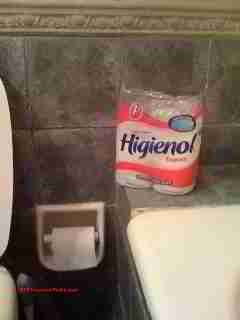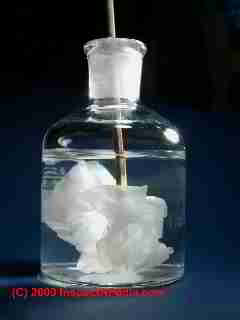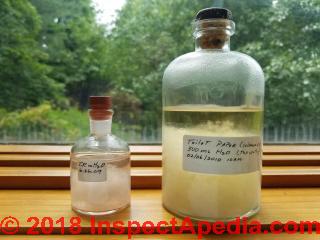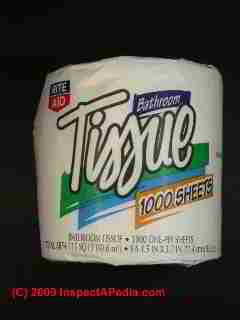 Bathroom Tissue Lab Test
Bathroom Tissue Lab Test
- POST a QUESTION or COMMENT about choosing toilet paper for use in home septic systems, chemical toilets, RVs, etc.
Toilet paper breakdown or biodegradation test:
What Happens to Toilet Paper in the Septic Tank? Do some toilet tissues break down better than others? Does it matter? This article describes and provide photos of a simple test demonstrating how bathroom tissue should be expected to break down inside of the septic tank.
We demonstrate a simple low-tech toilet paper test to explore what happens to toilet tissue when it enters the septic tank or sewer system.
InspectAPedia tolerates no conflicts of interest. We have no relationship with advertisers, products, or services discussed at this website.
- Daniel Friedman, Publisher/Editor/Author - See WHO ARE WE?
Testing Toilet Paper for Septic System Breakdown
Discussed here: A simple test demonstrates toilet paper break down in the septic tank.
Explanation of importance of septic tank settlement time; Does toilet tissue create a problem in the septic tank? Recommendations for use of recycled-paper toilet tissue versus ultra-soft fluffy toilet paper brands address using recycled paper versus cutting down standing trees; Recommendations for use of biodegradable toilet paper
This article is part of our series: SEPTIC SYSTEM INSPECTION & MAINTENANCE COURSE an online book on septic systems. Here we demonstrate a simple low-tech toilet paper test to explore what happens to toilet tissue when it enters the septic tank or sewer system.
Since large numbers of people throughout the world who have access to toilets are accustomed to flushing their used toilet tissue along with waste, we've begun a series of simple empirical tests of the breakdown of several types of widely-used toilet paper
At TOILET TISSUE CHOICES we also explained that in a conventional septic system using a tank and drainfield, ordinary toilet tissue does not harm the septic system.
That article addresses the questions of whether or not we should use special or bio-degradable toilet paper when a home is connected to a private septic system and what kinds of paper or toilet tissue may damage the septic tank or leach fields?
In that article we describe the impacts of using soft toilet tissue, recycled fiber toilet tissue, and other paper products that people might flush into a septic or sewer system.
There we also addressed the question: WHAT ABOUT PUTTING NO TOILET PAPER INTO THE SEPTIC TANK AT ALL?
The toilet tissue remains in the septic tank, kept from flowing into the drainfield by septic tank baffles, and eventually toilet tissue breaks down in the septic tank and is not a solid bulk problem at normal levels of usage.
To see just what actually happens to toilet paper in a septic tank produces photographs that some readers may not wish to examine closely, so in our forensic laboratory we made the simple toilet paper test illustrated here.
One square of Rite-Aid® low-cost bathroom tissue was inserted into a quartz-glass test jar containing approximately 100 ml of tap water (photo at left).
We capped and shook the jar of water and toilet paper for approximately 30 seconds (photo at left).
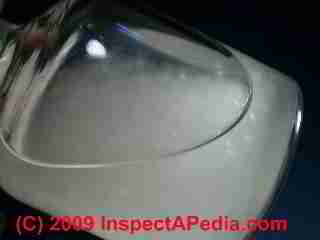 This agitation is more violent than what happens in a septic tank, but there too the incoming and out flowing sewage, combined in some systems with bacterial action and mechanical aeration, produces agitation of the sewage in the tank, including toilet tissue.
This agitation is more violent than what happens in a septic tank, but there too the incoming and out flowing sewage, combined in some systems with bacterial action and mechanical aeration, produces agitation of the sewage in the tank, including toilet tissue.
You can see that very quickly the toilet tissue separated into a large number of very small, fine paper fragments suspended in the water.
Still, we would not want even these small fragments to flow out of the septic tank into the drainfield, as soil clogging would follow, reducing the drainfield life. The job of septic tank baffles is precisely that of keeping floating scum and solids in the septic tank.
But what keeps these small particles of toilet paper (or other waste) in the septic tank if they are agitated into and mixed with septic liquid effluent that will indeed flow out through the septic tank outlet baffle and into the drainfield?
Time is the answer, or in septic-speak, settlement time.
During periods of inactivity mechanical agitation of sewage in the septic tank is reduced, allowing solids to either settle out into the sludge at septic tank bottom, or coagulate in the floating scum layer at the top of the septic tank.
You can see in this photo ) of our toilet paper test that after just 1/2 a minute the toilet paper fragments have already settled out and begun to collect on the bottom of our test jar.
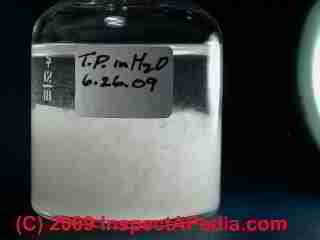 See EFFLUENT RETENTION TIME for details about septic tank settlement time.
See EFFLUENT RETENTION TIME for details about septic tank settlement time.
Further septic tank agitation during use may re-mix these toilet tissue fragments, causing them to break into still smaller fragments that again will settle out of the liquid, moving towards the septic tank bottom.
Eventually the cycle of agitation and settling will virtually dissolve the toilet tissue to very small microscopic paper fibers that may be digested further by fungal or bacterial action in the septic tank or drainfield.
Our toilet tissue test shown here was performed in simple tap water, without the benefit of septic tank microorganisms that would be expected to further break down bath tissue into ever smaller, septic-tank-digestible, fragments.
That is why when the septic tank is opened for pumping and cleaning, only the most recently-used toilet tissue is going to be found visible in the septic tank.
See SEPTIC TANK PUMPING SCHEDULE
We will keep this test in our laboratory and will provide here further updates and photos on what happens to toilet paper in plain tap water.
Testing RV-Type Toilet Paper Designed for Chemical Toilets
 In February 2010 we began a parallel study of RV type toilet paper (Coleman® brand) in tap water to watch for the rate of fiber breakdown.
In February 2010 we began a parallel study of RV type toilet paper (Coleman® brand) in tap water to watch for the rate of fiber breakdown.
Keep in mind that this version of toilet paper breakdown testing has (for now) excluded
- The effects on toilet tissue of bacteria or fungi found in the septic tank
- The effects on toilet tissue in the septic tank as it is agitated whenever new wastewater enters the tank
- The effects on toilet tissue of agitation in the septic tank caused by aerobic or other wastewater treatment processes that also agitate and oxygenate waste in the treatment tank
- The possible effects on toilet tissue breakdown of other chemicals or gases found in the septic tank
- The anticipated effects on toilet tissue breakdown in the wastewater holding tank when exposed to the manufacturer's recommended dose of chemical toilet additive used in portable toilets, or in boat and camper RV type sewage holding tanks.
But our lab photo (above) shows even without microscopic examination that by no means does this toilet tissue simply dissolve when it is placed in water.
Toilet Tissue Breakdown Test Update
Shown below are the same two toilet paper samples on 2018/06/20 - nine years after this toilet tissue degradation test was begun.
The small bottle sample on the left is conventional toilet tissue while the larger bottle on the right contains Coleman™ brand RV toilet tisse.
While there is some limited bacterial action going on in these samples, more bacterial action occurs in a normal septic tank where paper is broken down more-rapidly than in tap-water and toilet paper samples.
Be Sure to Pump the Septic Tank On Schedule
Comments on this sample are also found at TOILET TISSUE CHOICES
There we comment that any toilet tissue that has not broken down in the septic tank will be removed when the septic tank is pumped - on schedule. That septic tank cleanout or pumping is the most-critical step to maintain the septic system.
See SEPTIC TANK PUMPING SCHEDULE
Be Sure You are Using the Proper Treatment Chemical for RV Tanks, Chemical Toilets, or Graywater Holding Tanks
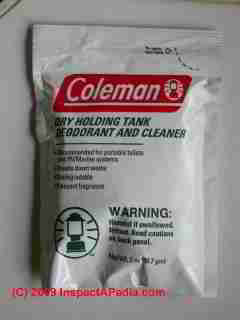 Chemicals intended as deodorants for chemical toilets, RV and marine sewage holding tanks, and similar equipment are produced by several companies including Coleman(see below) and Thetford's (Aqua-Kem® ).
Chemicals intended as deodorants for chemical toilets, RV and marine sewage holding tanks, and similar equipment are produced by several companies including Coleman(see below) and Thetford's (Aqua-Kem® ).
As Coleman® points out right on their Dry Holding Tank Deodorant and Cleaner, that product is intended for use only in portable toilets and RV/Marine toilet systems.
In sum, this is a deodorant and sewage stabilizer intended for portable toilets (chemical toilets) and RV sewage holding tanks where it is intended for brief (5-day) holding periods. Longer holding periods for sewage in these systems, or holding at higher temperatures may require a higher dose of the product.
The company's product labeling indicates that this substance
- will break down waste (presumably sewage) in the tank
- is biodegradable (presumably harmless to the environment when used as directed)
- provides a pleasant fragrance
- contains paraformaldehyde and thus could be poisonous to children - "Watch Out: keep this product away from children " (and presumably pets or other animals) and don't get the treatment chemical or its liquid mixture in your eyes or on your skin.
- "contains a chemical known to the state of California to cause cancer. Formaldehyde-free product is also available."
For graywater holding tanks in RVs and marine systems, Coleman® indicates that a separate product, Coleman® liquid deodorant and cleaner, is recommended in stead. See How to Use & Maintain a Chemical Toilet .
...
Continue reading at TOILET TISSUE CHOICES or select a topic from the closely-related articles below, or see the complete ARTICLE INDEX .
Or see TOILET TYPES, CONTROLS, PARTS
Suggested citation for this web page
TOILET TISSUE TEST at InspectApedia.com - online encyclopedia of building & environmental inspection, testing, diagnosis, repair, & problem prevention advice.
Or see this
INDEX to RELATED ARTICLES: ARTICLE INDEX to TOILET INFORMATION
Or use the SEARCH BOX found below to Ask a Question or Search InspectApedia
Ask a Question or Search InspectApedia
Try the search box just below, or if you prefer, post a question or comment in the Comments box below and we will respond promptly.
Search the InspectApedia website
Note: appearance of your Comment below may be delayed: if your comment contains an image, photograph, web link, or text that looks to the software as if it might be a web link, your posting will appear after it has been approved by a moderator. Apologies for the delay.
Only one image can be added per comment but you can post as many comments, and therefore images, as you like.
You will not receive a notification when a response to your question has been posted.
Please bookmark this page to make it easy for you to check back for our response.
IF above you see "Comment Form is loading comments..." then COMMENT BOX - countable.ca / bawkbox.com IS NOT WORKING.
In any case you are welcome to send an email directly to us at InspectApedia.com at editor@inspectApedia.com
We'll reply to you directly. Please help us help you by noting, in your email, the URL of the InspectApedia page where you wanted to comment.
Citations & References
In addition to any citations in the article above, a full list is available on request.
- New York Times: "What Mr. Whipple Didn't Say: Softer Paper is Costly to Forests", Leslie Kaufman, New York Times, 2/26/2009 p. A17
- Greenpeace: 2/18/2009 article at http://www.greenpeace.org/usa/press-center/reports4/tissueguide includes a downloadable .PDF file. The Greenpeace site reports "Did you know? Americans could save more than 400,000 trees if each family bought a roll of recycled toilet paper—just once. Recycled tissue products help protect ancient forests, clean water, and wildlife habitat. It's easier on the Earth to make tissues from paper instead of trees. Download our printable pocket-sized version of the Guide ."
Septic System References & Books
- "International Private Sewage Disposal Code," 1995, BOCA-708-799-2300, ICBO-310-699-0541, SBCCI 205-591-1853, available from those code associations.
- "Manual of Policy, Procedures, and Guidelines for Onsite Sewage Systems," Ontario Reg. 374/81, Part VII of the Environmental Protection Act (Canada), ISBN 0-7743-7303-2, Ministry of the Environment,135 St. Clair Ave. West, Toronto Ontario M4V 1P5 Canada $24. CDN.
- US HEW, MANUAL of SEPTIC TANK PRACTICE [PDF] 1975, U.S. Department of Health, Education and Welfare, Public Health Servicve, original source: https://nepis.epa.gov/
- Manual of Septic Tank Practice, US Public Health Service's 1957, reprinted in 1963, 1967, 1969 and in a 1975 edition given just above.
- SEPTIC TANK/SOIL-ABSORPTION SYSTEMS: HOW TO OPERATE & MAINTAIN [PDF] - , Equipment Tips, U.S. Department of Agriculture, 8271 1302, 7100 Engineering, 2300 Recreation, September 1982, web search 08/28/2010, original source: http://www.fs.fed.us/t-d/pubs/pdfimage/82711302.pdf.
- In addition to citations & references found in this article, see the research citations given at the end of the related articles found at our suggested
CONTINUE READING or RECOMMENDED ARTICLES. - Our recommended books about building & mechanical systems design, inspection, problem diagnosis, and repair, and about indoor environment and IAQ testing, diagnosis, and cleanup are at the InspectAPedia Bookstore . Also see our Book Reviews - InspectAPedia.
- Advanced Onsite Wastewater Systems Technologies, Anish R. Jantrania, Mark A. Gross. Anish Jantrania, Ph.D., P.E., M.B.A., is a Consulting Engineer, in Mechanicsville VA, 804-550-0389 (2006). Outstanding technical reference especially on alternative septic system design alternatives. Written for designers and engineers, this book is not at all easy going for homeowners but is a text I recommend for professionals--DF. US EPA ONSITE WASTEWATER TREATMENT SYSTEMS MANUAL [online copy, free] Top Reference: US EPA's Design Manual for Onsite Wastewater Treatment and Disposal, 1980, available from the US EPA, the US GPO Superintendent of Documents (Pueblo CO), and from the National Small Flows Clearinghouse. Original source http://www.epa.gov/ORD/NRMRL/Pubs/625R00008/625R00008.htm Onsite wastewater treatment and disposal systems, Richard J Otis, published by the US EPA. Although it's more than 20 years old, this book remains a useful reference for septic system designers. U.S. Environmental Protection Agency, Office of Water Program Operations; Office of Research and Development, Municipal Environmental Research Laboratory; (1980)
- Eco John® Innovative Toilet Solutions , Global Inventive Industries, Fountain Valley CA, PDF, product brochure
- "International Private Sewage Disposal Code," 1995, BOCA-708-799-2300, ICBO-310-699-0541, SBCCI 205-591-1853, available from those code associations.
- "Manual of Policy, Procedures, and Guidelines for Onsite Sewage Systems," Ontario Reg. 374/81, Part VII of the Environmental Protection Act (Canada), ISBN 0-7743-7303-2, Ministry of the Environment,135 St. Clair Ave. West, Toronto Ontario M4V 1P5 Canada $24. CDN.
- The NSFC Products List has an excellent list of design manuals/modules National Small Flows Clearinghouse (NSFC) now (2019/12/13) hosted at http://www.nesc.wvu.edu/ Tel: 304-293-4191 e-mail info@mail.nesc.wvu.edu.
he National Small Flows Clearinghouse (NSFC) was funded by the U.S. Environmental Protection Agency (EPA) to help America's small communities and individuals solve their wastewater problems through objective information about onsite wastewater collection and treatment systems. NSFC products and information are the only national resource of its type, dealing with small community wastewater infrastructure. or by telephone 800-624-8301 - In addition to citations & references found in this article, see the research citations given at the end of the related articles found at our suggested
CONTINUE READING or RECOMMENDED ARTICLES.
- Carson, Dunlop & Associates Ltd., 120 Carlton Street Suite 407, Toronto ON M5A 4K2. Tel: (416) 964-9415 1-800-268-7070 Email: info@carsondunlop.com. Alan Carson is a past president of ASHI, the American Society of Home Inspectors.
Thanks to Alan Carson and Bob Dunlop, for permission for InspectAPedia to use text excerpts from The HOME REFERENCE BOOK - the Encyclopedia of Homes and to use illustrations from The ILLUSTRATED HOME .
Carson Dunlop Associates provides extensive home inspection education and report writing material. In gratitude we provide links to tsome Carson Dunlop Associates products and services.


